
|
|
|
|
 |
|
Home Site Search Contact Us Subscribe
|
|
|
|
A Flexible Future: UCSF Genentech Hall by SmithGroup
San Francisco: Flexible laboratories, informal gathering spaces, and a soaring atrium emphasize collaboration among researchers. by ArchNewsNow July 29, 2004 The
University of California, San Francisco (UCSF), a research institution
dedicated to the health sciences, long ago outgrew its cramped campus in
western San Francisco. Unfortunately, neighborhood concerns and a steeply
sloping site severely limited expansion. The university found the solution in a
public/private partnership with Catellus Development Corporation, which was
developing the new 303-acre Mission Bay neighborhood south of downtown, along
the bay. The site’s first laboratory building, UCSF Genentech Hall, designed by
SmithGroup and opened at the end of 2002, houses 900 researchers and students,
offering a flexible environment that promotes collaboration. The long-term goal
is to attract private medical research and drug companies to form a biotech
cluster around the campus. With
laboratory design, flexibility is a particular challenge. Laboratories need
fixed benches for access to power, water, and compressed gas. As a result, reconfiguring
is expensive. At the same time, the pace of scientific research is quickening,
which means that research teams grow and shrink and the nature of their work
changes more rapidly than ever. Complicating matters even further, when
SmithGroup was called in to design the facility, the university had not yet
determined which scientists would be using the building. In this case, a
modular and generic approach provides the flexibility. Over
the last 15 years, UCSF has placed an increasing emphasis on collaboration
between researchers of different disciplines. The $142 million,
434,000-square-foot, five-story Genentech Hall consists of two main laboratory
wings, north and south of a central spine, and is designed to foster greater
interaction among biologists, chemists, and medical doctors. Older
laboratories generally link Principal Investigators (PI) and their assistants
to a particular lab, isolating them from others. At Genentech Hall, the design
groups PI offices together in office suites. Without walls dividing individual
labs, researchers work in larger sub-dividable lab spaces that share secondary
lab spaces. At the juncture between offices and laboratories,
lunch/lounge/library spaces offer places to gather informally within each
laboratory “neighborhood.” Dry erase boards near seating areas encourage the
sharing of ideas. All access to labs or offices is through these gathering
areas. Each lab neighborhood is connected by the wide central spine to the
five-story atrium and grand stair with interactive lounges overlooking the
lobby at each level; a coffee shop and auditorium further animate the atrium. The
basic lab modules are arranged in 14 neighborhoods containing both open and
closed labs, offices, and the library/lounge/lunch areas. Glazed acoustical
separations within the laboratory casework break the large six-, eight-, and
10-module suites into manageable areas that can be easily reconfigured. As a
research program changes in size, it can take on or relinquish benches as
needed. The benches have a desk at each end for lab technicians, protected from
spills by divider panels. Support
spaces are modular as well, and can be easily modified depending on research
needs. Identical 10’6” x 20’ generic support rooms are all outfitted with a
common building infrastructure of lab utilities, lighting, sink, and wall
backing plate to support shelves or cabinets. Researchers can choose options
that customize these generic spaces into a tissue culture room, equipment room,
multi-use room, or fume hood room. All benches, cabinets, and shelving are
moveable to allow for future modification. Every room has branch lines for
piped utilities, which means systems can be reconfigured without having to shut
down large areas of the lab. In open labs, the design places utilities in the
ceiling, with connections running down through the divider panels to every
bench. Half the benches are designed as moveable tables free to be replaced
with lab equipment as required. The
emphasis on collegiality began with the master plan and design guidelines
created by UCSF and its consultants, Boston-based Machado Silvetti Associates.
The master plan describes the sequence of public open spaces and campus
connective spaces that bring visitors and researchers to each facility. As the first
completed building on the campus, Genentech Hall helps form the context for
future projects, and links the campus’s hierarchy of open space to the
building’s public areas inside and out. Genentech Hall’s outdoor colonnaded
338-seat amphitheater overlooks the campus green. Along with the glazed atrium,
the amphitheater creates a collegial space that defines the building’s main
entrance. On the south façade, a second-floor café with terrace also connects
interior and exterior. The
master plan and design guidelines call for all buildings on the campus to be
divided into a one-story base, a four-story body, and a recessed cap housing
the building’s mechanical equipment. While the bases and bodies of campus
buildings are to remain fairly rectilinear, the tops of buildings, particularly
of laboratories, are to take on more fanciful shapes, giving the campus a
distinctive skyline. Genentech Hall features pyramidal forms at the building
top. The master plan
also defines a shared palette of building materials and colors, as well as a
shared approach to façade and window articulation. The building’s exterior
cladding consists of an Italian “classico” travertine marble, chosen to
harmonize with the master plan’s color palette. A brown “noce” travertine
highlights window surrounds and banded accents, while the building’s mass is a
lighter beige. Variations in windows give exterior expression to the interior
program. Large punched openings define the labs, while broader areas of glazing
front the offices and other interaction areas, such as the atrium, conference
rooms, stairways, and café. All glazing is highly transparent, making
activities within the building visible to passersby. "We
designed a building that communicates stability and quality appropriate for a
public institution,” comments SmithGroup Design Principal William L.
Diefenbach, AIA. “It was not our intention to place an 'object' on the campus
to compete with future buildings, but to create the first piece of a new
neighborhood that would look beautiful and understated now and in half a
century or more." The
project was awarded a 2003 Lab of the Year – Special Mention by R&D
Magazine. Catellus
donated 34 of the campus’s 43 acres to UCSF. The university and the developer
plan to work together to bring private biotechnology companies to the
neighborhood, which will also include housing, public facilities, and open
spaces. The campus is becoming a catalyst for a community of scholars, turning
what was once an empty industrial and warehouse district into a thriving
neighborhood, and providing an economic engine for the city. The university has
two laboratory buildings, a campus community center, and student housing
already under construction at Mission Bay, and plans to add a parking garage,
childcare center, and two additional biomedical research buildings over the
next several years. Project
credits: Architect:
SmithGroup Design
Team: William L. Diefenbach, AIA (Design Principal), Stephen G. Peppler, AIA
(Project Manager), Luminita Ruva-Ciupitu, AIA, Suzanne Napier, AIA, Lyn Kent,
AIA (Project Architects), Lawrence E. Bailey, Jr., Assoc. AIA, Lise Barriere,
MAOQ, Byron Bronston III, AIA, Roxanne Malek, AIA, Hiroko Miyaki, AIA, Irene
Monis, AIA, Charles David Moore, AIA, Mona Thaler, Johnny Wong, AIA (Project
Team) Exterior Design Consultant: Zimmer
Gunsel Frasca Partnership Landscape: Peter Walker and Partners Construction Company:
Clark Construction Group, Inc. Laboratory
Consultant: Earl Walls Associates Structural:
Rutherford & Chekene MEP: Gayner
Engineering Civil: KCA
Engineering Audio-Visual/Telecommunications:
Infrastructure Design Associates Lighting:
Horton Lees Acoustics:
Colin Gordon Associates Cost
Estimating: Davis Langdon Adamson Fire
Protection: Fire Protection Consultants Vertical
Transport: Syska & Hennessy Curtain
Wall: Curtain Wall Design and Consulting Photography:
Timothy Hursley; Mark Luthringer SmithGroup, Inc. is an 800-person international,
architecture, engineering, interiors, planning and landscape architecture firm.
It specializes in the health, learning, science and technology, workplace, and
urban design and planning markets. SmithGroup has offices in Ann Arbor,
MI; Chicago; Detroit; Los Angeles; Madison, WI; Minneapolis; Phoenix; San
Francisco; and Washington, D.C. Also featured on ArchNewsNow.com: Dhaka Apollo Hospital
in Bangladesh by SmithGroup |
(click on pictures to enlarge) 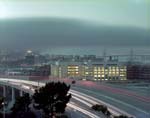 (Timothy Hursley) UCSF Genentech Hall is the first completed building at the university's new campus in the Mission Bay neighborhood.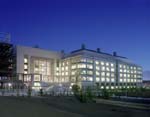 (Timothy Hursley) North elevation facing future campus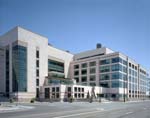 (Timothy Hursley) Southwest corner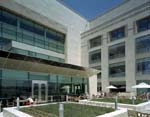 (Timothy Hursley) Cafeteria and terrace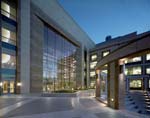 (Timothy Hursley) Atrium overlooks amphitheater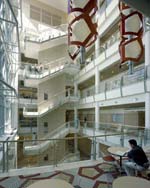 (Timothy Hursley) Atrium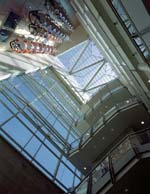 (Timothy Hursley) Atrium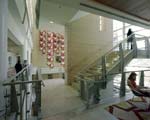 (Timothy Hursley) Atrium stairway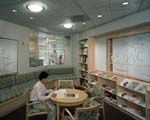 (Timothy Hursley) Informal interaction area on path to lab spaces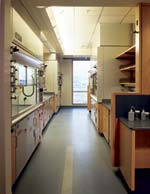 (Mark Luthringer) Chemistry laboratory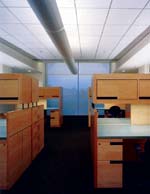 (Mark Luthringer) Computational laboratory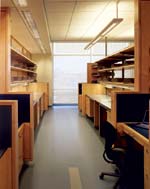 (Mark Luthringer) Biology laboratory (SmithGroup) Typical floor plan |
© 2004 ArchNewsNow.com